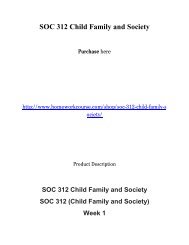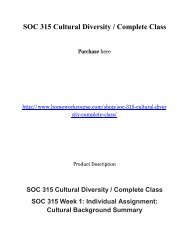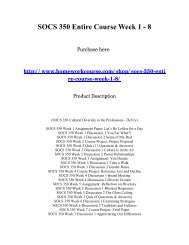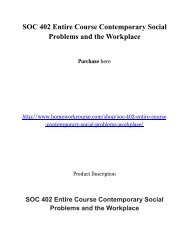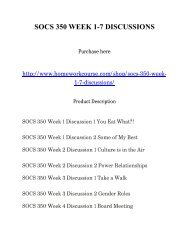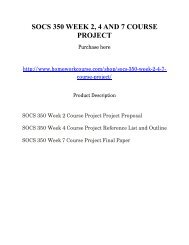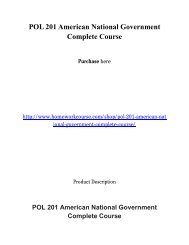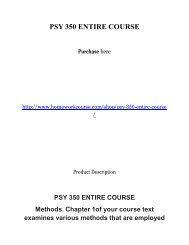SOCS 350 Quizzes Week 2 and 6
Create successful ePaper yourself
Turn your PDF publications into a flip-book with our unique Google optimized e-Paper software.
<strong>SOCS</strong> <strong>350</strong> <strong>Quizzes</strong> <strong>Week</strong> 2 <strong>and</strong> 6<br />
Purchase here<br />
http://www.homeworkcourse.com/shop/socs-<strong>350</strong>-quizzes-wee<br />
k-2-6/<br />
Product Description<br />
<strong>SOCS</strong> <strong>350</strong> <strong>Week</strong> 2 Quiz<br />
1. (TCOs 1 & 2) The existence of a wide variety of cultures <strong>and</strong> subcultures represented<br />
within a society is _____.<br />
2. (TCOs 1 & 2) A category of people distinguished from the dominant society on the basis of<br />
distinctive <strong>and</strong> identifiable cultural characteristics is _____.<br />
3. (TCOs 1 & 2) Caucasians with origins other than Northern or Western European who still<br />
hold <strong>and</strong> value their ethnic identity but do so without social cost are _____.<br />
4. (TCOs 3 & 4) The tangible artifacts created by a culture are _____.<br />
5. (TCOs 3 & 4) The disconnect in a society that occurs when material culture changes more<br />
rapidly than nonmaterial culture is _____.<br />
6. (TCOs 1, 3, & 4) The process that occurs when concepts, ideas, language, <strong>and</strong> behaviors<br />
cross cultural boundaries is _____.<br />
7. (TCOs 1 & 2) Evaluating cultural differences in relationship to one's own cultural<br />
st<strong>and</strong>ards is _____.<br />
8. (TCOs 3 & 4) An example of a person managing differences by avoidance would be<br />
9. (TCOs 3 & 4) Which of the following statements is/are true about cultures over time?<br />
10. (TCOs 1 & 2) Methods of communication vary among cultures. Some use direct <strong>and</strong><br />
simple methods while others use indirect <strong>and</strong> complex means. Which cultures prefer
indirect ways of communicating <strong>and</strong> use of gestures, facial expressions, some vague<br />
comments, <strong>and</strong> so on?<br />
11. (TCOs 1 & 2) Name <strong>and</strong> briefly describe the three categories of ethical theories introduced<br />
in the book. Briefly describe how the caring ethical theory can be used to underst<strong>and</strong> <strong>and</strong><br />
impact diversity at work <strong>and</strong> school.<br />
<strong>SOCS</strong> <strong>350</strong> <strong>Week</strong> 6 Quiz<br />
1. (TCOs 6 & 7) Why is the following statement false? You can easily figure out how to<br />
communicate with your coworkers as long as you know their ethnicity.<br />
2. (TCOs 6 & 7) Millennial workers (1980–2000) tend to be motivated by<br />
3. (TCOs 6 & 7) The term white privilege means that<br />
4. (TCOs 4 & 7) Something that can generate ethnocentric responses or defensive reactions,<br />
such as voice, appearance, attitude, or behavior, is called _________.<br />
5. (TCOs 4 & 7) Time <strong>and</strong> manners are examples of this type of trigger:<br />
6. (TCO 8) The social position in life that comes as a result of behavior or things that happen<br />
over which one has no control (race, gender, <strong>and</strong> so on) is called _____.<br />
7. (TCOs 4, 5, & 7) What organizational strategies can be put in place to demonstrate that<br />
diversity is valued <strong>and</strong> to promote a culture of nondiscrimination? Discuss two specific<br />
ways in which organizations can accomplish these goals.<br />
8. (TCO 8) From the reading in Chapter 14, briefly describe general racial disparities <strong>and</strong><br />
inequities that exist in the workplace, education, <strong>and</strong> justice system. How can these<br />
disparities be removed?





